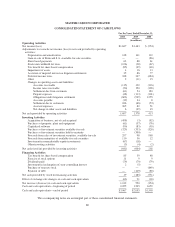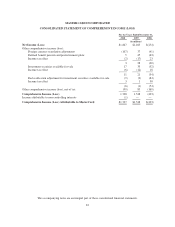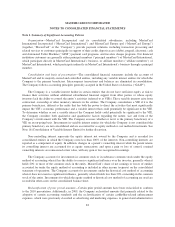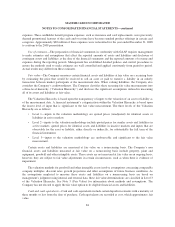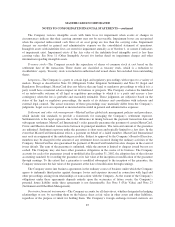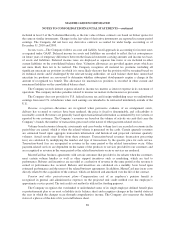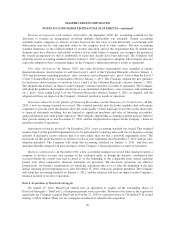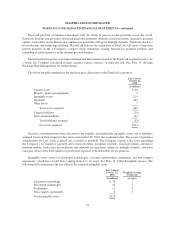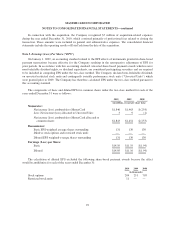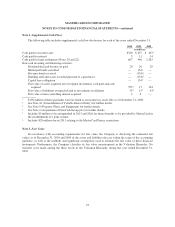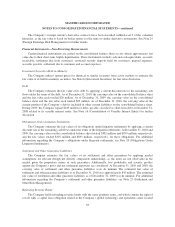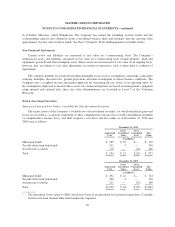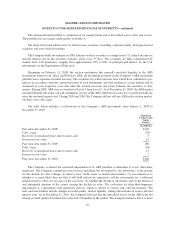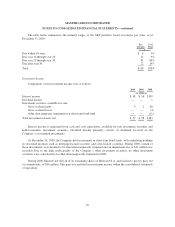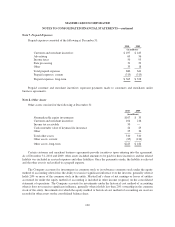MasterCard 2010 Annual Report Download - page 100
Download and view the complete annual report
Please find page 100 of the 2010 MasterCard annual report below. You can navigate through the pages in the report by either clicking on the pages listed below, or by using the keyword search tool below to find specific information within the annual report.MASTERCARD INCORPORATED
NOTES TO CONSOLIDATED FINANCIAL STATEMENTS—continued
Revenue arrangements with multiple deliverables—In September 2009, the accounting standard for the
allocation of revenue in arrangements involving multiple deliverables was amended. Current accounting
standards require companies to allocate revenue based on the fair value of each deliverable, even though such
deliverables may not be sold separately either by the company itself or other vendors. The new accounting
standard eliminates (i) the residual method of revenue allocation and (ii) the requirement that all undelivered
elements must have objective and reliable evidence of fair value before a company can recognize the portion of
the overall arrangement fee that is attributable to items that already have been delivered. The Company will
adopt the revised accounting standard effective January 1, 2011 via prospective adoption. The Company does not
expect the adoption to have a material impact on the Company’s financial position or results of operations.
Fair value disclosures—In January 2010, fair value disclosure requirements were amended to require
detailed disclosures about transfers to and from Level 1 and 2 of the Valuation Hierarchy effective January 1,
2010 and disclosures regarding purchases, sales, issuances, and settlements on a “gross” basis within the Level 3
(of the Valuation Hierarchy) reconciliation effective January 1, 2011. The Company adopted the new guidance
for disclosures about transfers to and from Level 1 and 2 of the Valuation Hierarchy effective January 1, 2010.
The adoption did not have an impact on the Company’s financial position or results of operations. The Company
will adopt the guidance that requires disclosure of a reconciliation of purchases, sales, issuances, and settlements
on a “gross” basis within Level 3 (of the Valuation Hierarchy) effective January 1, 2011, as required, and the
adoption will have no impact on the Company’s financial position or results of operations.
Disclosure about the Credit Quality of Financing Receivables and the Allowance for Credit Losses—In July
2010, a new accounting standard was issued. This standard provides new disclosure guidance that will require
companies to provide more information about the credit quality of their financing receivables in the disclosures
to financial statements including, but not limited to, significant purchases and sales of financing receivables,
aging information and credit quality indicators. The Company adopted this accounting standard upon its effective
date, periods ending on or after December 15, 2010, and the adoption had no impact on the Company’s financial
position or results of operations.
Impairment testing for goodwill—In December 2010, a new accounting standard was issued. This standard
requires Step 2 of the goodwill impairment test to be performed for reporting units with zero or negative carrying
amounts if qualitative factors indicate that it is more likely than not that a goodwill impairment exists. The
provisions for this pronouncement are effective for fiscal years beginning after December 15, 2010, with no early
adoption permitted. The Company will adopt this accounting standard on January 1, 2011, and does not
anticipate that this adoption will have an impact on the Company’s financial position or results of operations.
Business combinations—In December 2010, a new accounting standard was issued. This standard requires a
company to disclose revenue and earnings of the combined entity as though the business combination that
occurred during the current year had occurred as of the beginning of the comparable prior annual reporting
period, only when comparative financial statements are presented. The disclosure provisions are effective
prospectively for business combinations for which the acquisition date is on or after the beginning of the first
annual reporting period beginning on or after December 15, 2010, with early adoption permitted. The Company
will adopt this accounting standard on January 1, 2011, and the adoption will have no impact on the Company’s
financial position or results of operations.
Note 2. Acquisition of DataCash Group plc
On August 19, 2010, MasterCard entered into an agreement to acquire all the outstanding shares of
DataCash Group plc (“DataCash”), a European payment service provider. Pursuant to the terms of the acquisition
agreement, the Company acquired DataCash on October 22, 2010 at a purchase price of 334 million U.K. pound
sterling, or $534 million. There was no contingent consideration related to the acquisition.
90


